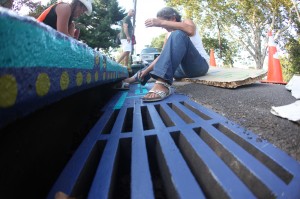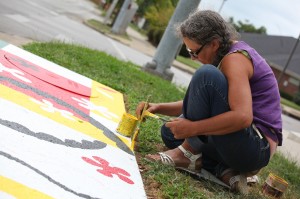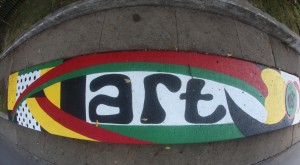By Beth Connors-Manke
Editor’s note: In part one of this article, Beth introduced Blake Eames and Claudia Michler, the artists behind Made You Look!, an arts-based environmental activism project. Eames and Michler painted storm sewer drains around downtown, neighborhoods near UK, and the near north side. Made You Look! won an EcoART grant from the city to help with the storm sewer public education campaign.
After my last official interview with Eames and Michler – I saw and talked to them many times after that as they knelt over drains, brushes in hand – I had mixed feelings about the storm sewer project. I loved the art, of course, no question, but the problems that had led to the need for the art and for sewer education weighed on me. As much as I may appreciate the art, the environmental degradation that it signaled was serious and dangerous.
Our conversations had suggested there were at least two aspects to the project: the first, the joy in the art; the second, the decline in the city’s infrastructure and an ignorance about water pollution.
Second, the Bad, or A Walk Down a Flooded Memory Lane
The Environmental Protection Agency (EPA) began examining Lexington’s sewer systems in 2003. Tasked with making sure municipalities complied with the Clean Water Act of 1972, the EPA found what the city had already known: the antiquated and overwhelmed sewer system was an environmental and health hazard. In certain parts of the city, heavy rains brought nightmares for residents and public works: sewage would back up into basements and overflow into the stormwater system. Storms also brought raw sewage flowing out of pump stations and manholes. The net result was that untreated sewage from sanitary sewers (the ones that take waste from your house) ended up in our waterways.
“The storm that’s brewing under our feet,” as Eames and Michler called it in their proposal, was a convergence of issues related to funding and development. If you read back through the more than 100 Herald-Leader articles since 2006 on the problem, you find an intriguing story, but one with no single protagonist and no clear villain. Things just fell apart — literally — which is what happens to a city when there’s little funding for large-scale infrastructure repair and less than vigilant urban planning. I started reading the Herald-Leader articles dating from 2006 because I knew the EPA’s hammer came down on the city that year.
One June 2006 editorial sketched the EPA-related financial bind created in the Republican 1980s.
“The Clean Water Act of 1972 struck a great environmental bargain between federal and local governments. Municipalities would help clean up streams, rivers and bays by upgrading sewage treatment systems that might once have been state-of-the-art but had become grossly inadequate. The federal government would pay for the biggest part of this massive infrastructure rehab. The feds backed out on their end of the bargain when the Reagan administration insisted on deleting the funding provisions in 1987. And an unfunded mandate was born.”
“Lexington now finds itself on the receiving end of that unfunded mandate,” the editorial continued. “For those who don’t know, an unfunded mandate is a requirement imposed by one government on another with no money to pay for it.”
It also didn’t help that the city had no dedicated revenue stream for the sewer systems such that it could substantially tackle the problem. Add to that the fact that, until the recent crisis forced by the EPA, the city’s administrative structure kept maintenance of the sanitary sewer and storm sewer separate, even though the two types of sewers sometimes intertwine.
Politically, the situation came to a head in November 2006 when the EPA sued the city for violations of the Clean Water Act related to an ineffective storm sewer system. However, two months earlier the problem unfolded as a human drama when Lauren Brooke Fannin and Lindsey Marie Harp drown. The two young women were swept away in floodwaters near the intersection of Nicholasville Road and Alumni Drive during the torrential and historic September 23, 2006 rainstorm. The two left their taxicab when a police officer turned it back because of high water. Believing they could make it on foot, the women waded into the water.
While the women’s deaths weren’t a direct result of the storm sewer problems – UK holds that it has met drainage requirements since 1993 – the tragedy did, for a time, become a clarion call for change in Lexington’s approach to water and development. A little over a week after the drownings, a Herald-Leader editorial lamented the deaths of Fannin and Harp, along with all the other damage done by the “out-of-control water” that came with the September 23 storm.
“If we had needed another sign that this is not the moment to expand our city,” the editorial argued, “that should have been it….this is the moment to take a break from suburban development, get our house in order and figure out what we want to be.”

Made You Look artists working on the Pac Man-themed piece at Park and High across from Woodland Park. Photo by Brian Connors Manke
Remember what Eames and Michler said about why people were responding so often and so strongly to the color in their storm drain art?
Eames: “I think that everything is getting so grey and so concrete. And it’s us doing it — even if we’re not physically doing it, it’s our need that is creating all this concrete and asphalt.”
Michler: “The automobile, actually.”
People love the color, the artists suggest, because we’ve paved over so much natural beauty.
The aging and gnarled sewer system is a problem, but so is increased development that covers more soil. It seems, though, that we can’t exactly blame Hamburg for the problems around downtown. An October 2006 Herald-Leader article absolves that ever-expanding pavement kingdom:
“Many cities are built on rivers, and water flows toward downtown and the river. Lexington sits on a slight dome, so water flows away from downtown and into creeks that eventually find the Kentucky River.”
“While more roofs and pavement can increase runoff,” the article continues, “more development in Hamburg, for example, would not affect flooding in downtown neighborhoods. That’s because the two areas are in different watersheds, which in this case are called sewersheds. Rain that falls in Hamburg flows north, into North Elkhorn Creek. Rain that falls in Chevy Chase flows west, into Town Branch.”
It seems that at the heart of the problem is citizens’ collective lack of understanding of our own landscape. We may tout our rolling hills, protect area farms with the Purchase of Development Rights Program (PDR), sell ourselves as the horse capital, but on a basic level we just don’t get how our land works. We’ve covered it up, and now we need the Made You Look! art to remind us that yes, we need clean watersheds, and yes, we need beauty and color around us.
We’re paying for that ignorance. The city is dishing out hundreds of millions for the repair of the sewer systems, and property owners are now responsible for their contributions to the problem. Single-family homes have a set storm sewer fee, and other properties are assessed based on square footage of impervious surface (such as pavement and roofs).
But let’s not think we excuse ourselves by the new fees. What’s the point of paying the fee if we charge ahead, still polluting our creeks with the pet waste, oil, trash, grease, and lawn chemicals that wash into storm sewers? Those sewers along the curb – where we let our grass clippings and litter pile up — those are the sewers that go directly to the nearest body of water. Lexington feels pretty strongly about who should own the water around here; shouldn’t we also care deeply about central Kentucky’s watersheds, especially since we can secure their quality without any complicated utility take over?
Let’s not enjoy Eames and Michler’s painted drains while forgetting their purpose isn’t solely as public art. Made You Look! may be a more homegrown public art than Horse Mania (which is a branding campaign more anything else), but there is more to the project than the art. Unlike Horse Mania, the painted storm drains tell us something real and true about our home: we’re polluting it.
Learn more about stormwater pollution and how to avoid it at LFUCG’s www.livegreenlexington.com. Find out which watershed you live in (there are nine in Fayette County — I promise you live in one of them, and more than likely it’s one of the polluted ones). We’re also sorry that we neglected to tell you in our last issue that you can keep up with Made You Look! on Facebook. Search for “Made You Look.”






Bill
I remember the flooding in the uk area when I lived in the vicinity from the 80s until ’08. Once I watched cars parked on Rose Lane literally floating down the street. And that area is fairly high. When Lauren’s picture was in the paper I remembered being helped by her once at the Kroger pharmacy on Euclid. I remembered the drain but never though of it being a dangerous thing before then. It was about a 3 foot pipe that drained a large area of uk near Nicholasville Rd, and went under the road there. In one of those rains you would have been swept off your feet and pulled under and into it with tremendous force if you were anywhere near it.
kaferine de nerve
Made You Look! is a nice step in getting people’s attention about stormwater. I love the idea of combining art and the environment.
I appreciate the irony of a trickling revenue stream when it comes to something as important as water quality.
Shout outs to Blake and Claudia for finding a positive way to open eyes.
dmayer
And thank you Blake…I know I’ve loved both the color and the attention to storm runoff concerns, not to mention simply passing by, often quietly, while you two were working diligently and joyfully around town.
Blake Eames
I am blown away by Beth Connors-Manke’s 2 part series about Made You Look: A storm drain art project. She eloquently wrote about this crisis with our storm sewer in a powerful way. I am one half of the Made You Look storm drain team and with Claudia Michler we tackled this project to educate this city about this crisis. Connors-Manke said with words what we have been shouting with paint and art!
THANK YOU BETH!
Beth C.M.
Blake: Glad you felt the series did your work justice. Thanks for tacking the issue!